#lunar lander training vehicle
Text
Did you know that NASA engineers considered the failure rate of some critical shuttle parts to be about 1 in 100 (significantly greater than what NASA upper-management considered the failure rate to be, and what was considered at all acceptable by the certification process)?
Do you know that NASA engineers currently have no idea how many rocket launches the next mission in the Artemis program (in 2 years!) is meant to involve, because the mission plan relies on SpaceX being contracted to deliver a supply of cryogenic fuel to the crewed Orion (™ Lockheed-Martin) capsule in orbit - a procedure that 1: has never been attempted before on any spacecraft, let alone the Orion™ capsule, not even in uncrewed technology demonstration flights; and 2: would require an as-of-yet unknown number of SpaceX 'Starship' launches, because said vehicle does not actually exist at time of writing?
Did you know they're planning on using this 'starship' as the crewed lander? A design for a lunar ascent vehicle, that is, that does not use hypergolic fuel, that relies on a swing-out crane as the only entry and egress point? During the original moon landings, the LEM had so many redundant methods to make sure it got astronauts off the surface of the moon, that in the most absurd, extreme case, where every single mechanism fails, there's a procedure trained into the astronauts to climb around the outside of the capsule, take a pair of bolt-cutters from the equipment box, physically cut the couplings holding the capsule to the lander stage, and take off to get home. Artemis' proposed lander, on the other hand, is planned to be a vehicle whose design didn't even include heatshields until it was realised it would obviously need heatshields, which are ceramic tiles bolted after-the-fact directly through the steel hull, because SpaceX had decided to mass-produce the original-design hull sections all at once for all the 'starships' first, before doing any integrated testing.
We're seeing the exact attitude that led to the shuttle disasters not being prevented now expressing itself in (and even through) the Artemis program, a project pushed harder and faster through the gates than it should be, by a government (and NASA administration thereby) desperate to advance the eponymous Artemis Accords (that goes unsigned by China, Russia, and much of the world) and reneg on all previous space charters that onsidered ownership, commercial exploitation, and military usage of space forbidden. Something bad is going to happen, and it's going to happen for the sake of SpaceX and the military-industrial complex at large.
2K notes
·
View notes
Text
The Indian Space Agency published and almost immediately deleted a photo of its station on the Moon
What secrets are they hiding there?

The Indian Space Research Organization (ISRO) showed a photo of the successfully landing vehicle of the Chandrayaan-3 mission from Earth satellite orbit, but soon deleted it. This caused a lot of speculation among netizens, especially since ISRO did not explain the hasty deletion of the unique image.
"The Chandrayaan-2 orbiter's high-resolution camera currently has the best resolution of any around the Moon," ISRO captioned the image.
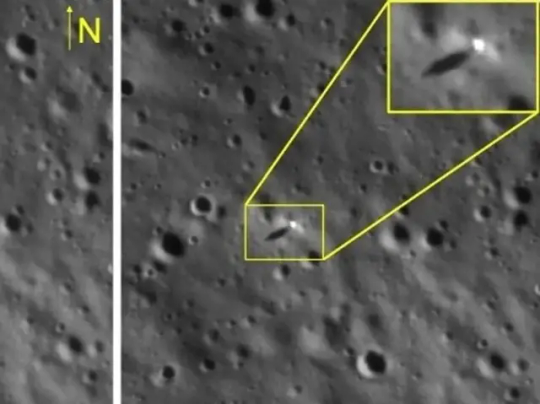
The photo was deleted a few minutes after publication, but many people, including journalists, managed to copy it
Netizens began to wonder why ISRO hid the photo of the descent module on the Moon: was it a publication that was not approved by management, or was the space agency afraid that people would see something secret in the photo?
Meanwhile, Photoshop enthusiasts decided to answer these questions by creating pictures full of stereotypes about Indians.
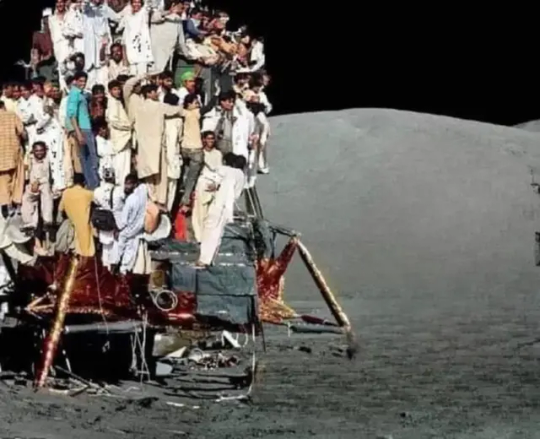
Some believe that on the Vikram lander, if you look closely, you can see passengers who confused the train with a spacecraft.
Jokes aside, Chandrayaan-3 is safe and sound and will soon begin exploring the South Pole of the Moon, where spacecraft from other countries have not yet landed on the Moon.
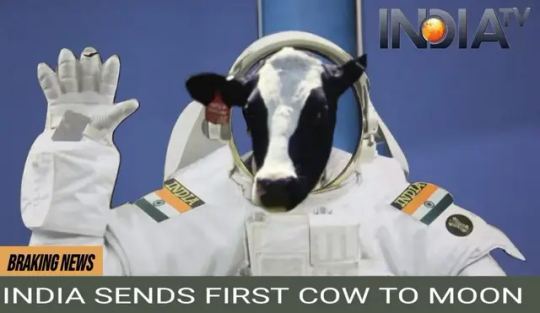
Or hiding a cow
Let us recall that the successful landing of the Vikram lander on the lunar surface took place on Wednesday , August 23. And this date will go down in the history of Indian space exploration: India has now officially become the fourth “lunar power” after the USSR, USA and China.
The first lunar mission, Chandrayaan-1, was launched into lunar orbit in November 2008. It did not involve landing - the automatic station worked in orbit around the Earth’s satellite for a year and a half and ceased to exist. On July 22, 2019, ISRO sent Chandrayaan-2 to the Moon with a landing module, but the device crashed while attempting to land. At the same time, the Chandrayaan-2 orbital station continues to operate in lunar orbit and sends pictures to Earth; it was from it that photographs of the landing module of the Chandrayaan-3 mission were taken.

And perhaps a dance duet
Let us add that the Russian state corporation Roscosmos, after the failure with the Luna-25 spacecraft, plans to launch the next automatic station to the Moon a year or two earlier than planned. The head of the corporation, Yuri Borisov, urged not to make a tragedy out of the crash of Luna-25 and to continue working. him According to , during a working meeting at NPO Lavochkina, it was decided that Luna-26 would go to the Earth’s satellite in 2025-2026. Previously, the launch of this device was planned for 2027.

According to the Americans, this is what the Indian lunar rover looks like, which they decided not to show for the time being.
#The Indian Space Agency published and almost immediately deleted a photo of its station on the Moon
1 note
·
View note
Text
Chandrayaan-3: India's Successful Lunar Landing

Chandrayaan-3, India's latest lunar mission, has achieved a historic milestone by successfully landing on the moon's surface. This achievement comes after the setback of its predecessor, Chandrayaan-2, in 2019. The landing, which took place as planned on Wednesday at 5:34 am PT (6:04 pm IST), makes India the fourth nation globally to achieve a soft landing on the moon, following the former Soviet Union, the U.S., and China. What sets this achievement apart is that India is the first country to successfully land on the lunar south pole, a region of great scientific interest.
Addressing the audience after the successful landing, ISRO chairman S. Somanath expressed his gratitude to the thousands of scientists, engineers, staff, and industries involved in the mission. Chandrayaan-3's success is a testament to their hard work and dedication.
The Chandrayaan-3 mission, launched on July 14th by the Indian Space Research Organization (ISRO), aims to demonstrate safe lunar landing and rover operations while conducting scientific experiments. Despite a budget of less than $75 million, the spacecraft consists of a propulsion module, lander, and rover, equipped with seven scientific instruments.
To overcome the challenges faced by its predecessor, Chandrayaan-3 features improved sensors, software, and propulsion systems in its lander. Rigorous simulations and testing were conducted to ensure a robust landing. The lander will conduct experiments on various aspects, including seismic vibrations, lunar temperature, and spectral signatures of Earth.
The Chandrayaan-3 rover, similar to that of Chandrayaan-2, will accompany the lander. Both the lander and rover have a mission life of one lunar day, equivalent to 14 Earth days.
This achievement comes 14 years after India's first moon landing mission in 2008, which discovered evidence of water molecules in the lunar atmosphere. While the Chandrayaan-2 lander-rover mission faced challenges during its touchdown, the orbiter continues to study the moon from orbit and played a critical role in locating the landing site for Chandrayaan-3.
India's space exploration efforts have seen significant growth in recent years, with over a hundred space tech startups contributing to the development of launch vehicles, satellites, and earth imaging technology. The country has also introduced a space policy to foster collaboration between private companies and government entities.
Prime Minister Narendra Modi emphasized that India's moon mission is a shared achievement that belongs to all of humanity. He noted that India's approach of "one Earth, one family, one future" resonates globally and that India's success will benefit future moon missions by other countries.
ISRO has a list of missions in progress, including the long-anticipated human spaceflight mission, Gaganyaan, and the solar observatory project, Aditya L1, to study the sun.
India's collaboration with NASA, including signing the Artemis Accords, signifies its growing role in international space exploration. NASA is providing advanced training to Indian astronauts and planning to send them to the International Space Station next year. Additionally, ISRO and NASA are working together to launch a low-Earth observatory (LEO) in 2024, which will provide valuable data for studying Earth's ecosystems, ice mass, vegetation, sea level, and natural disasters.
Chandrayaan-3's successful lunar landing is a significant step forward for India's space program, inspiring further exploration and collaboration on the global stage.
Read the full article
0 notes
Text
Hacking the Feminist Disabled Body » The Journal of Peer Production

💾 ►►► DOWNLOAD FILE 🔥🔥🔥
Selection of space news for breakfast: Maxar will offer the military to connect directly to its satellites via a mobile terminal, and China will launch a large space telescope. Orbex showed a prototype of an environmentally friendly launch vehicle. The U. Colombia is the 19th nation to join the Accords, unveiled in , and the third in Latin America after Brazil and Mexico. Virgin Orbit is buying two more planes that will help get satellites to the final frontier. The rocket leaves Earth tucked beneath the wing of a carrier airplane, which drops it at an altitude of about 35, feet 10, meters. This air-launch strategy increases flexibility and responsiveness, Virgin Orbit representatives say. They are a satellite dish and the terminal. Such a set of equipment allows connecting to their satellites. According to Maxar President Daniel Jablonski, the company is now receiving a huge number of requests from government organizations and new equipment is the answer to them. The four-person crew who will fly on the all-private Polaris Dawn mission will begin training for their ride. It will include the first commercial spacewalk using SpaceX spacesuits. However, this will not be the only record, as the mission should also reach the highest near-Earth orbit in history. It will exceed the orbit of the ISS three times. Spire Global said it is installing Ku-band antennas from fellow smallsat operator Kepler Communications on at least three satellites to offer higher capacity data services beginning next year. The reusable Prime rocket, the first micro-launcher developed in Europe, now awaits tests on a launch pad at Space Hub Sutherland, a new spaceport in northern Scotland, which received planning permission in August Services, and Viasat. Beijing has confirmed plans announced earlier to launch a large space observatory , the capabilities of which will be comparable to the Hubble telescope. It will be launched at the end of using the Changzheng-5B rocket and will begin observations in A market ecosystem that incentivizes the rapid development and fielding of advanced Space Traffic Management STM technologies will be a key enabler to the sustainable growth of the space economy. As defined by the International Academy of Astronautics, STM protects future sector growth by encouraging the development and application of technology to preserve access to space and assets already in orbit. STM technologies must be fielded today with support from both government and industry. The United Kingdom is getting serious about beaming solar power from space and thinks it could have a demonstrator in orbit by Over 50 British technology organizations, including heavyweights such as aerospace manufacturer Airbus, Cambridge University and satellite maker SSTL, have joined the U. Space Energy Initiative, which launched last year in a quest to explore options for developing a space-based solar power plant. While NASA and other space agencies intend to leverage local resources as much as possible—a process known as in-situ resource utilization ISRU —creating lunar bases will still require lots of materials and machinery to be shipped from Earth. In a recent study, Philip Metzger and Greg Autry reviewed the cost and energy consumption of building landing pads on the lunar surface. After considering various construction methods, they determined that a combination of additive manufacturing and polymer infusion was the most efficient and cost-effective means. Read also: James Webb telescope has completed optics setup, and Russian spacecraft will not be able to fly to the Chinese orbital station: News Digest. Related: The largest airplane in the world has made a new flight NASA will support the creation of a second lunar lander for the Artemis program The US will impose sanctions against the Russian space program NASA to switch to commercial communication systems NASA stops the rehearsal of launch of a lunar rocket due to a fuel leak. Load more.
1 note
·
View note
Text
Flightline: 40 - Bell LLRV/LLTV

-One of the LLRVs in flight over Edwards, with a TB-47B and B-57A 55-0665, nicknamed “Snoopy” (which was modified to house a test version of the AN/ASG-18 radar for the F-108 and F-12 programs) in the background. | Photo: NASA / Dryden Flight Research Center
Edwards AFB, 1 January 1965
Built by Bell Aerosystems, the 2 Lunar Lander Research Vehicles and 3 Lunar Lander Training Vehicles (collectively nicknamed Flying Bedsteads) were used to develop controls for the Lunar Landers used by the Apollo program, as well as train the pilots for the Landers.
NASA selected Bell as the contractor for the LLRV program based on the company’s experience with VTOL aircraft, and issued a study contract in 1961 to develop a system to simulate landing on the Moon. Bell had also been studying the idea independently, and by February of 1963 the company was awarded a contract worth $3.6 million ($30.5 million today) to produce the LLRVs, with the first two craft expected at Edwards for flight testing within 14 months.

-Line drawing of the LLRV, showing the simplicity of its construction as well as its dimensions. | Illustration: NASA
“Aircraft” only in the most general sense, the LLRVs and LLTVs were a series of truss sections built from aluminum tube. A single GE CF700/TF34 was placed in the center of the vehicle, oriented vertically downward and mounted on a gimbal to keep the axis of thrust centered. The turbofan would lift the LLRV to an appropriate altitude (500 feet or less) , at which point it would be throttled back to simulate the 1/6th gravity of the Moon. two rockets, powered by hydrogen peroxide and throttleable between 100lbf and 500lbf, would be used to slow the craft’s descent rate and provide horizontal movement. Sixteen smaller RCS motors, also powered by H2O2,were mounted in pairs and controlled pitch, roll and yaw. In an emergency, six solid fuel rockets could be used to maintain the 5/6th support if the turbofan failed, allowing a safe landing. Finally, one of the first zero/zero ejection seats was fitted, which could catapult the pilot to safety even from zero altitude and zero speed (hence the name).

-Engine test of LLRV #1 in late 1964. | Photo: NASA/DFRC
Both LLRVs were shipped from Bell’s plant to Edwards in April of 1964, though #2 was shipped in pieces and assembled there to keep costs down. After initial tests on a tilt table, the vehicles were moved to the South Base area of Edwards and flight testing began in October. Test flights were carried out by FRC pilots Joe Walker and Con Mallick, as well as Army helicopter test pilot Jack Kleuver and NASA pilots Joe Algranti and H. E. Ream. After the test series at Edwards, the LLRVs were modified, adding the three-axis hand controllers and throttles of the future LM, as well as a cockpit enclosure (made from Styrofoam to keep weight down) to simulate the view from the LM.

LLRV #2, after modifications. Also note the landing pegs instead of the casters present on the preceding picture. | Photo: NASA/DFRC

-Picture of a preserved LLTV, showing the instruments in the cockpit. | Photo: NASA
In December of 1966, LLRV #1 was transported to NASA Houston, followed by #2 in January of ‘67, and NASA’s flights began on 27 March 1967, with Neil Armstrong piloting #1 at Ellington AFB. Armstrong, as well as other pilots of the craft, were quick to point out that given the LLRV’s operations envelope, use of the ejection seat was their only option if something went wrong, which was proven on 6 May 1968, when a control failure forced Armstrong to eject at 200 feet.
youtube
A review board found that the fuel for the RCS thrusters had run out, aggravated by high winds on the day of the flight. NASA decided to terminate further flights of the LLRV at this point, as the improved LLTV were due to be shipped to Ellington from Bell. At the time of the accident, LLRV #1 had completed 198 flights accident-free, with #2 completing 6 flights.
In March of 1967, Bell Aerosystems was granted a contract worth $5.9 million ($45.7 M today) to produce three Lunar Lander Training Vehicles, an advanced version of the LLRV used to train the LM pilots. The first vehicle arrived at Ellington in June of 1968, with first flight carried out by JSC’s Aircraft Operations Division (AOD) head Joe Algranti in August. Tests lasted until 8 December, when Algranti lost control of the vehicle and ejected just 3/5th of a second before impact.
youtube
The accident review found that, due to the decision to not test the LLTV in a wind tunnel prior to flight tests, the full capabilities and limitation of the RCS were unknown. The decision was then made to fly LLTV #3 to NASA Langley in a Super Guppy for wind tunnel testing.
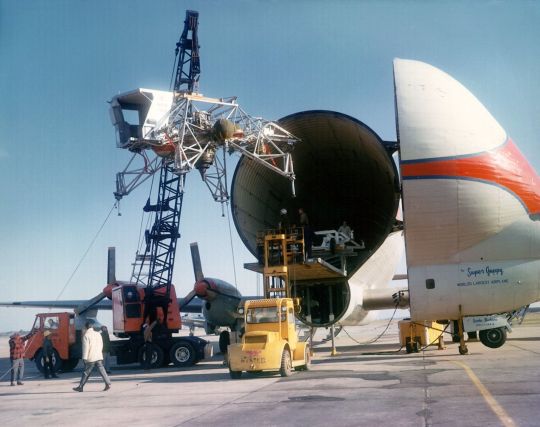
-LLTV #3 being loaded into the Super Guppy. | Photo: NASA

-LLTV #3 inside the 30x60 foot wind tunnel at NASA Langley. | Photo: NASA
Testing on the vehicle lasted from 7 January to 7 February 1968, and determined that the Styrofoam cabin was inducing a yaw at sideslip angles exceeding -2°, which quickly exceeded the RCS’ ability to counteract. NASA took the simple expedient of removing the top of the cabin, which eliminated the yaw. Data from the tests also allowed NASA to build a preliminary flight envelope, though this would have to be checked with test flights, as the LLTV’s engine could not be run in the tunnel. A Flight Readiness Review Board was convened in March of 1969 to review the findings of the accident board, as well as the data from the tunnel tests, and on 30 March approved a resumption of flight tests, which were completed in March of 1969, leaving Neil Armstrong a month to complete his LLTV training prior to the Apollo 11 launch.
After the successful landing of Apollo 11, the remaining LM pilots each took their turn in the LLTV, though #3 was destroyed on 29 January ‘71 after an electrical failure at 200 feet.
youtube
The LLRV and LLTV were invaluable tools in the Moon landing, and were some of the few hardware simulators to get get airborne. Then Chief Astronaut of NASA Deke Slayton said simply: “[There was] no other way to simulate moon landings except by flying the LLRV.”
Unsurprisingly, only two of the craft survived the program:
LLRV #2 is on display at the Armstrong Flight Research Center (FKA NASA Dryden), which is apparently Fort Knox as I cannot find a pic anywhere.
LLTV #2, also known as NASA 952, is hanging in the lobby of the NASA Johnson Space Center:

-LLTV #2 in the JSC lobby. | Photo: NASA
#nasa history#nasa#llrv#lltv#lunar lander research vehicle#lunar lander training vehicle#bell aircraft#apollo program#lunar lander#space#moon landing#Youtube
52 notes
·
View notes
Text
Remember the Women Who Made #Apollo50th Possible
As the world celebrates the 50th anniversary of the historic Moon landing, we remember some of the women whose hard work and ingenuity made it possible. The women featured here represent just a small fraction of the enormous contributions made by women during the Apollo era.
Margaret Hamilton, Computer Programmer

Margaret Hamilton led the team that developed the building blocks of software engineering — a term that she coined herself. Her systems approach to the Apollo software development and insistence on rigorous testing was critical to the success of Apollo. In fact, the Apollo guidance software was so robust that no software bugs were found on any crewed Apollo missions, and it was adapted for use in Skylab, the Space Shuttle and the first digital fly-by-wire systems in aircraft.
In this photo, Hamilton stands next to a stack of Apollo Guidance Computer source code. As she noted, “There was no second chance. We all knew that.”
Katherine Johnson, Aerospace Technologist
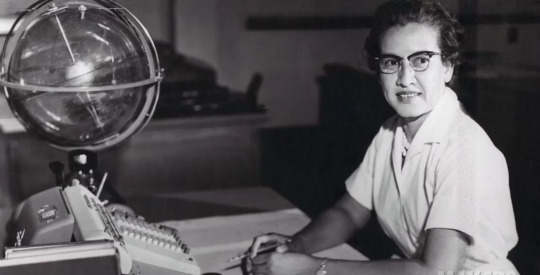
As a very young girl, Katherine Johnson loved to count things. She counted everything, from the number of steps she took to get to the road to the number of forks and plates she washed when doing the dishes.
As an adult, Johnson became a “human computer” for the National Advisory Committee for Aeronautics, which in 1958, became NASA. Her calculations were crucial to syncing Apollo’s Lunar Lander with the Moon-orbiting Command and Service Module. “I went to work every day for 33 years happy. Never did I get up and say I don't want to go to work."
Judy Sullivan, Biomedical Engineer
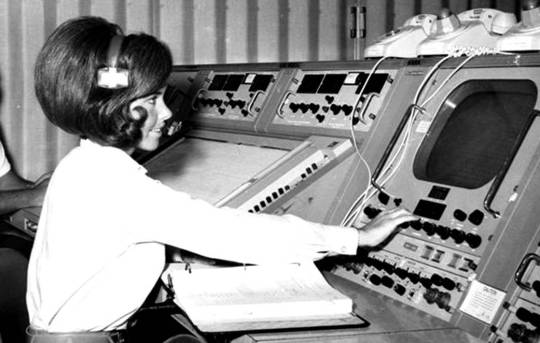
This fabulous flip belongs to biomedical engineer Judy Sullivan, who monitored the vital signs of the Apollo 11 astronauts throughout their spaceflight training via small sensors attached to their bodies. On July 16, 1969, she was the only woman in the suit lab as the team helped Neil Armstrong suit up for launch.
Sullivan appeared on the game show “To Tell the Truth,” in which a celebrity panel had to guess which of the female contestants was a biomedical engineer. Her choice to wear a short, ruffled skirt stumped everyone and won her a $500 prize. In this photo, Sullivan monitors a console during a training exercise for the first lunar landing mission.
Billie Robertson, Mathematician
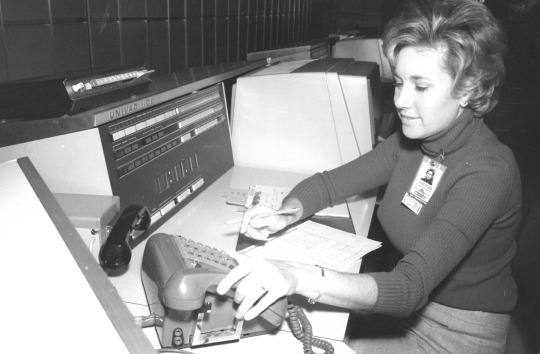
Billie Robertson, pictured here in 1972 running a real-time go-no-go simulation for the Apollo 17 mission, originally intended to become a math teacher. Instead, she worked with the Army Ballistic Missile Agency, which later became rolled into NASA. She created the manual for running computer models that were used to simulate launches for the Apollo, Skylab and Apollo Soyuz Test Project programs.
Robertson regularly visited local schools over the course of her career, empowering young women to pursue careers in STEM and aerospace.
Mary Jackson, Aeronautical Engineer
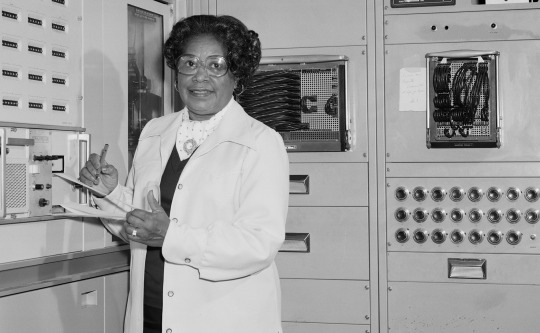
In 1958, Mary Jackson became NASA’s first African-American female engineer. Her engineering specialty was the extremely complex field of boundary layer effects on aerospace vehicles at supersonic speeds.
In the 1970s, Jackson helped the students at Hampton’s King Street Community center build their own wind tunnel and use it to conduct experiments. “We have to do something like this to get them interested in science," she said for the local newspaper. "Sometimes they are not aware of the number of black scientists, and don't even know of the career opportunities until it is too late."
Ethel Heinecke Bauer, Aerospace Engineer
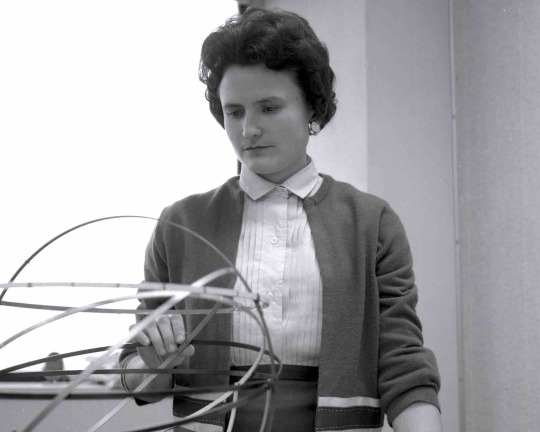
After watching the launch of Sputnik in October 1957, Ethel Heinecke Bauer changed her major to mathematics. Over her 32 years at NASA, she worked at two different centers in mathematics, aerospace engineering, development and more.
Bauer planned the lunar trajectories for the Apollo program including the ‘free return’ trajectory which allowed for a safe return in the event of a systems failure — a trajectory used on Apollo 13, as well as the first three Apollo flights to the Moon. In the above photo, Bauer works on trajectories with the help of an orbital model.
Follow Women@NASA for more stories like this one, and make sure to follow us on Tumblr for your regular dose of space: http://nasa.tumblr.com.
#apollo 11#apollo50th#women in STEM#history#nasa#space#women of NASA#Moon#Moon landing#lunar landing#STEM#mathematics#aerospace#apollo
15K notes
·
View notes
Text
Choosing rocks on Mars to bring to Earth
NASA - Perseverance Mars Rover logo.
April 3, 2020
If you could bring something back from Mars to Earth, what would you choose? This question is becoming reality, as ESA opens a call for scientists to join a NASA team working to determine which martian samples should be collected and stored by the Perseverance rover set to launch this Summer.
Mars landscape
Perseverance is a standalone mission seeking signs of habitable conditions on our neighbour planet, but it is also part of the international Mars Sample Return campaign that ESA Member States agreed to finance last year during Space19+.
Perseverance rover
Traveling over 53 million km to Mars, landing, collecting samples and launching a vehicle to return to Earth is unprecedented. This campaign will span a decade and involve four launches, including three from Earth and the first launch from another planet.
Mars Sample Return overview infographic
Interplanetary geo-caching
Sample Fetch Rover for Mars Sample Return campaign
When Perseverance lands on Mars it will scout the area for over a year. One of its main tasks will be to collect samples in cigar-sized metal cylinders that it will leave on the surface for pickup at a later date. As part of this international collaboration, ESA plans to provide a sophisticated Sample Fetch Rover to be operated during NASA’s Sample Retrieval Lander mission in the middle of this decade.
Earth Return Orbiter catching Mars sample capsule
The ESA rover will collect the samples that the Perseverance rover gathered and bring them to the lander, where they will be carefully stored in a Mars Ascent Vehicle (MAV). The MAV will launch the sample container from the martian surface, placing it in orbit around Mars.
Earth Return Orbiter leaving Mars orbit
Another important ESA contribution will be the biggest and most robust spacecraft flying to Mars – the Earth Return Orbiter that will rendezvous with the sample and bring it to Earth.
Packing for a return to Earth
Earth Return Orbiter releasing Mars sample capsule
Although the full campaign is in its early project phase, scientific experts must be selected now so they can begin training and operate alongside the Perseverance science team to enhance the value of the samples that will be collected. The selected scientists will also have to anticipate the needs of future investigators who may analyse these samples for a very diverse range of studies on Earth.
Martian soil
“We encourage applications from experts outside of the space field,” says ESA’s interim Mars Sample Return Programme Scientist Dr. Gerhard Kminek. “We need field geologists and laboratory experts who know how to pick the right samples based on information from the instruments that Perseverance has on-board.”
Mars Sample Return Earth Return Orbiter elements
ESA’s human spaceflight team leader adds, “experts selected through this call will receive training to form part of the international team of martian-geologists-at-a-distance. These are exciting times and we are looking forward to receiving the best proposals Europe has to offer.”
Uncovering the secrets of our Solar System
Studying Mars samples on Earth will allow scientists to use instruments more powerful than anything that could be flown on robotic missions. The chance to learn and share resources, including sending samples to the best laboratories around the world, offers incredible opportunities for new discoveries.
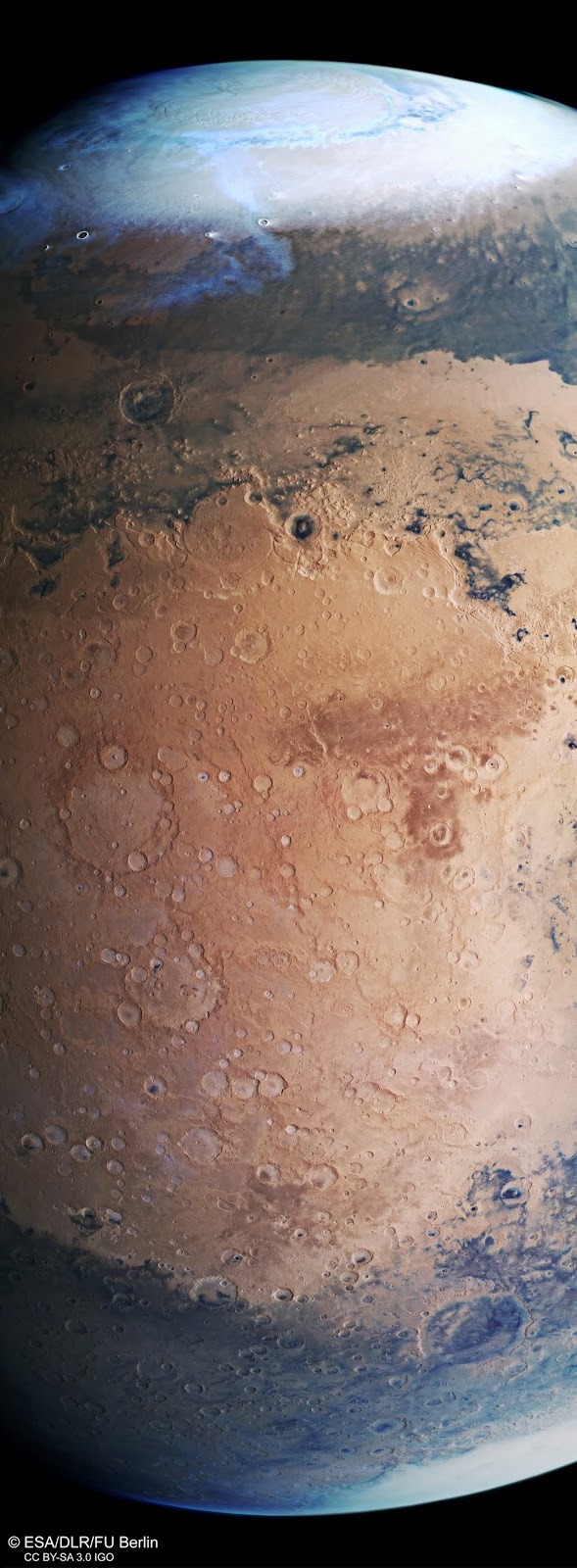
Mars Express view of Terra Sabaea and Arabia Terra
Samples may be analysed again and again, enabling new information to be extracted – much like with lunar samples brought to Earth in the 1960s and 1970s, which continue to reveal new discoveries to this day.
Gerhard concludes, “There are many reasons to study Mars, but one of the most pressing is that, while life arose and evolved on Earth, we still don’t know if life had a chance on Mars. Planetary scientists can study rocks, sediments and soils for clues to uncover the geological and potential biological history of Mars. Then, by comparing those findings with Earth we also learn more about our own planet.”
Apply for this opportunity to contribute to ground-breaking science through ESA’s Announcement of Opportunity page for Human and Robotic Exploration research: https://www.esa.int/spaceflightAO
Related links:
Perseverance: https://mars.nasa.gov/mars2020/
Mars Sample Return campaign: https://www.esa.int/Science_Exploration/Human_and_Robotic_Exploration/Exploration/Mars_sample_return
Mars Express: http://www.esa.int/ESA_Multimedia/Missions/Mars_Express
Human and Robotic Exploration: http://www.esa.int/Science_Exploration/Human_and_Robotic_Exploration
Images, Videos, Text, Credits: ESA/NASA/JPL-Caltech/ATG medialab.
Greetings, Orbiter.ch
Full article
99 notes
·
View notes
Photo
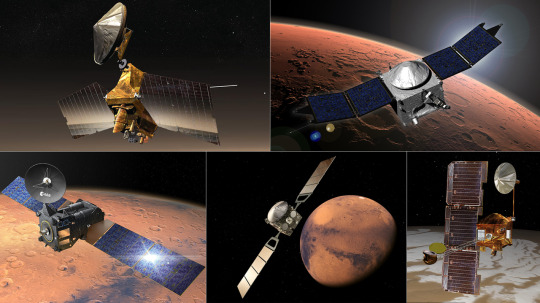
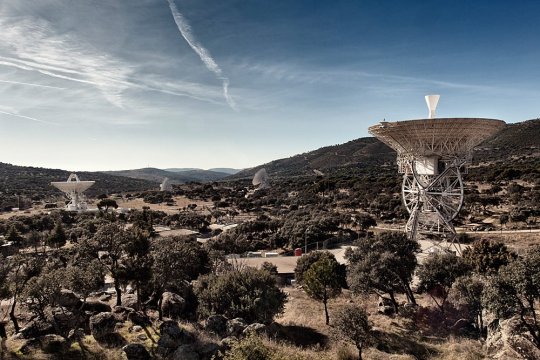
The Mars Relay Network Connects Us to NASA’s Martian Explorers A tightly choreographed dance between NASA’s Deep Space Network and Mars orbiters will keep the agency’s Perseverance in touch with Earth during landing and beyond. When NASA’s Mars 2020 Perseverance rover touches down with the Ingenuity Mars Helicopter on the Red Planet on Feb. 18, they won’t be alone. From orbit, two robotic buddies will be playing a special role in the event by checking in on the mission’s vital signs from the moment Perseverance enters the atmosphere to long after it makes its first tracks on the Martian surface. NASA’s Mars Reconnaissance Orbiter (MRO) and the Mars Atmospheric and Volatile EvolutioN (MAVEN) orbiter are a part of the Mars Relay Network, a constellation of spacecraft that serves as a lifeline to the current surface missions on Mars – NASA’s Curiosity rover and InSight lander. While some commands and telemetry can be sent directly to and from Earth, for the most part, the huge quantities of science data collected by rovers and landers cannot, because it would take too long. Most data traveling back to Earth must first be sent to the Mars orbiters overhead, which then transmit the data tens of millions of miles through interplanetary space to radio antennas on Earth, including the antennas of NASA’s venerable Deep Space Network (DSN). “It is a huge endeavor to maintain communications with our spacecraft throughout the solar system, but Mars surface missions take this commitment to another level,” said Bradford Arnold, DSN project manager at NASA’s Jet Propulsion Laboratory in Southern California. “Since Mars Global Surveyor (MGS) arrived in orbit in 1997, a steady stream of orbiters has been added, carrying relay radios and antennas, which provide highly efficient communications between surface landers and Earth. While the choreography of this relay scheme is now somewhat commonplace for assets in place, it is still extremely challenging to coordinate all the communication links for the very brief time during a lander’s arrival.” This dance will ensure that the world can watch Perseverance’s entry, descent, and landing – a harrowing sequence of events that will begin as the rover’s interplanetary cruise ends. Over the Horizon As Perseverance enters the Martian atmosphere inside its protective aeroshell, the rover will switch between several of its onboard antennas to stay in contact with Earth. Some of these antennas use powerful X-band transmissions that can send small amounts of data directly to the DSN. Others use ultra high frequencies (or UHF) to communicate with MRO and MAVEN. Managed by JPL for NASA’s Space Communications and Navigation program (SCaN), the DSN consists of several parabolic radio antennas at ground stations in Southern California, near Madrid, Spain, and outside Canberra, Australia. This configuration allows mission controllers to communicate with spacecraft throughout the solar system at all times throughout Earth’s daily rotation. During Perseverance’s landing, Madrid’s antennas will be trained on Mars, taking the lead when receiving data. The Goldstone complex near Barstow, California, will also be listening in as a backup. Since the landing of NASA’s Mars Exploration Rovers Spirit and Opportunity in 2004, science data has been routinely relayed via the Mars orbiters to the DSN, beginning with MGS and then NASA’s veteran Odyssey orbiter, which has been circling Mars since 2001. Because the final two minutes of Perseverance’s descent and landing will be mostly beyond Mars’ horizon from Earth’s perspective, “direct-to-Earth” X-band communications will be impossible, and the rover will communicate with Earth solely via MRO and MAVEN when it lands. In orbit since 2006, MRO was designed as a science mission and to act as a communications relay for landed surface missions. But it received an upgrade to prepare for Perseverance’s landing. “In the past year, the software of the MRO spacecraft and its UHF radio have been updated to allow the near-immediate return of data collected during EDL. MRO will capture the telemetry transmitted by Perseverance and use its 3-meter [10-foot] dish to transmit it immediately to Earth,” said Roy Gladden, manager of the Mars Relay Network at JPL. “We call this a ‘bent pipe’, which allows us to get word from Perseverance even though Mars is blocking our view from Earth.” First Word From Jezero As MRO relays Perseverance’s landing in near-real-time, engineers in mission control hope to confirm landing – and receive the first image – soon after 12:55 p.m. PST (3:55 p.m. EST). Because of the distance the signal has to travel from Mars to Earth, the spacecraft will have landed (known as “spacecraft event time”) 11 minutes and 22 seconds earlier. Later, at about 4:27 p.m. PST (7:27 p.m. EST), Odyssey will fly over the landing site and communicate with the rover to confirm its health. The next relay session after that will be at about 6:36 p.m. PST (9:36 p.m. EST) by ESA’s (the European Space Agency’s) Trace Gas Orbiter (TGO), which will also check in on Perseverance’s health and relay any images the rover has transmitted from the landing site. In addition, MAVEN will capture the entire landing with a data-rich broad spectrum recording, and will send the information back to Earth several hours after landing. This data could be used to fill in any telemetry (engineering data) from the rover during EDL that was missed by MRO during the initial relay, and provide other measurements of the event. This buddy system helps ensure that little data is lost during Perseverance’s historic landing in Jezero Crater while also confirming the health of the rover and its precise location. Science Operations Of course, communications don’t stop after landing. That’s when the complicated task of sending commands to Perseverance and receiving the rover’s huge science data output will begin. During its mission, the rover will have all of the orbiters in the Mars Relay Network for support – including NASA’s MRO, MAVEN, Odyssey, and ESA’s TGO, which has been playing a key role in the network for the past few years. Even ESA’s Mars Express orbiter will be available for emergency communications should the need arise. While the NASA orbiters communicate exclusively with the DSN, the ESA orbiters also communicate via the European Space Tracking network and ground stations located in Russia. Although the Mars Relay Network has expanded to include more spacecraft and more international partners, with every new surface mission comes added complexity when scheduling the relay sessions for each orbiter flyover. “Curiosity and InSight are near enough to each other on Mars that they are almost always visible by the orbiters at the same time when they fly over. Perseverance will land far enough away that it can’t simultaneously be seen by MRO, TGO, and Odyssey, but sometimes MAVEN, which has a larger orbit, will be able to see all three vehicles at the same time,” added Gladden. “Since we use the same set of frequencies when communicating with all three of them, we have to carefully schedule when each orbiter talks to each lander. We’ve gotten good at this over the last 18 years as rovers and landers have come and gone, including collaborating with ESA, and we’re excited to see the Mars Relay Network set new throughput records as it returns Perseverance’s huge data sets.” Ultimately, this communications endeavor connecting Earth and Mars will enable us to see high-resolution images (and hear the first sounds) captured by Perseverance, and scientists will be able to further our knowledge about the Red Planet’s ancient geology and fascinating astrobiological potential. More About Perseverance A key objective of Perseverance’s mission on Mars is astrobiology, including the search for signs of ancient microbial life. The rover will characterize the planet’s geology and past climate, pave the way for human exploration of the Red Planet, and be the first mission to collect and cache Martian rock and regolith. Subsequent missions, currently under consideration by NASA in cooperation with ESA, would send spacecraft to Mars to collect these sealed samples from the surface and return them to Earth for in-depth analysis. The Mars 2020 mission is part of a larger NASA initiative that includes missions to the Moon as a way to prepare for human exploration of the Red Planet. Charged with returning astronauts to the Moon by 2024, NASA will establish a sustained human presence on and around the Moon by 2028 through NASA’s Artemis lunar exploration plans. JPL, which is managed for NASA by Caltech in Pasadena, California, built and manages operations of the Perseverance rover. TOP IMAGES....Five spacecraft currently in orbit about the Red Planet make up the Mars Relay Network to transmit commands from Earth to surface missions and receive science data back from them. Clockwise from top left: NASA’s Mars Reconnaissance Orbiter (MRO), Mars Atmospheric and Volatile EvolutioN (MAVEN), Mars Odyssey, and the European Space Agency’s (ESA’s) Mars Express and Trace Gas Orbiter (TGO). Credit: NASA/JPL-Caltech, ESA LOWER IMAGE....The Deep Space Network has ground stations in Madrid (Spain), Goldstone (Southern California), and Canberra (Australia). Pictured here, Madrid’s radio antennas will take the lead in receiving telemetry from the Mars Relay Network during Perseverance’s entry, descent and landing. Credit: NASA/JPL-Caltech
4 notes
·
View notes
Text
A Hitchhiker’s Guide to the Space Race: What You Need to Know About the Space Race in 2020
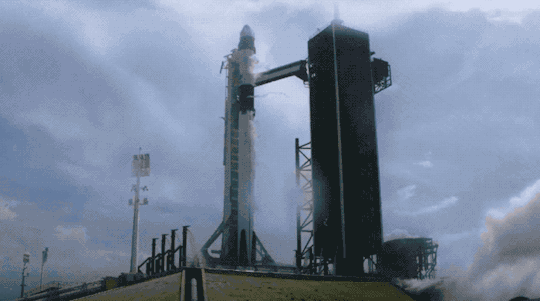
‘3…2...1…0. Ignition. Lift-off… Go NASA! Go Space X! Godspeed!’ These words uttered before the Crew Dragon spacecraft launch on May 30th, 2020 are all too familiar to us today, and the generations that have grown up in an era in which space travel is possible. The countdown, NASA, the behemoth that is the rocket, the agonising anticipation, and the eventual relieving launch are all at this point usual sights, and feelings associated with a standard space launch. Yet this event was different in so many ways to a typical launch and offered something new. The new, and revolutionary technology on display was undoubtably a part of this, with the rocket, and space suits looking like something straight out of a sci-fi movie, and the rocket’s reusable Falcon booster being landed with previously unseen precision. However, another noticeable element of the launch was the participants involved. Of course, as previously mentioned NASA were involved in the launch, but they were not alone in this endeavour. Sharing the honour with NASA on this occasion was Elon Musk, and his Space X company, with the launch marking the first time a private company has sent humans into space, and a spacecraft to the International Space Station (ISS). As such it can be argued Space X in 2020 is currently leading in a new ‘Space Race.’ This begs several questions. What is a Space Race? Who are the competitors is today’s Space Race? Who is winning? And should we even encourage such a competition?
The First Space Race (1955-1975)
The original ‘Space Race,’ has been defined by Space.com as a ‘series of competitive technology demonstrations between the United States, and the Soviet Union, aiming to show superiority in spaceflight… a tense global conflict that pitted the ideologies of capitalism, and communism against one another.’ This first Space Race started with announcements four days apart in 1955 from Leonid I Sedov of the Soviet Union, and James C Hagerty of the United States that the two nations intended to launch the first manmade satellites into orbit. The Soviets were first to succeed in this effort, launching their Sputnik I satellite in October 1957. Following this, on October 1st, 1958 NASA opened, but was able to achieve little compared to the Soviet space programme in its early years, with the Soviet Union taking more victories, and making history by putting both the first man (Yuri Gagarin), and first woman (Valentina Tereshkova) in space on April 12th, 1961, and June 16th, 1963 respectively. It was in between these two events in 1961 that President John F Kennedy (JFK) challenged NASA to send a man to the moon ‘before this decade is out,’ resulting in the establishment of the Apollo Programme. It is through this program that NASA was able to eventually turn the tide, and on July 20th, 1969, landed on the moon and the US ‘effectively won,’ the Space Race. This Space Race is largely regarded as coming to an end with the collaboration of the US, and Soviets on the Apollo-Soyuz mission in 1975, which saw a US Apollo craft, and Soviet Soyuz craft dock with one another, and the crew shake hands. Since then, the US, and Soviets have largely co-operated on space projects together. Particularly the ISS, described by NASA as ‘the most politically complex space exploration programme ever undertaken,’ has seen extensive US-Soviet co-operation, as well as widespread international collaboration, with 15 countries in addition to the ‘[principle]… space agencies of the United States, Russia, Europe, Japan, and Canada, being involved in the ISS. In addition to this, 18 countries in total have visited the ISS. Evidently, the Space Race no longer exists in its initial form, and the US, and Soviet Union (Now Russia) are no longer competitors, but rather allies. But who are the participants in the Space Race today?’

The New Space Race
China
China is arguably a candidate for this new Space Race. With a ‘trade war,’ declared by Donald Trump ongoing between the US, and China since 2018, and the two countries blaming each other for the COVID 19 pandemic, it is clear a great deal of economic, and political animosity exists between the two nations. This combined with China’s exclusion from the International Space Station in 2011, and an already ongoing battle for ‘technology primacy,’ in which (in Cold War fashion) Trump accused China of using its Huawei devices for spying has naturally set up China, and the US for a space industry conflict reminiscent of the original Space Race. China conducted the most launches of any nation in 2019 and is ‘the only country in the world to obtain all industrial categories listed in the United Nations industrial classification,’ leading the world in both steel, and aluminium production. Despite this ‘China has suffered setbacks on… its heavy-lift launch vehicle program,’ and as a result of exclusion from co-operation with other space agencies ‘lags behind in its human spaceflight, and space station programme.’ As a result, whilst China can be viewed as a contender in the Space Race in 2020, the country is certainly not amongst the most powerful within the space industry. However, it should be recognised that ‘China has all the technology available, and figured out,’ and with so many of the materials necessary for the construction of space equipment being domestically produced, China could be a major power within the space industry in the near future and may be able to turn things around similar to the US in the Space Race of the 20th Century.
Private Companies
Arguably, the more interesting focus of the Space Race currently though is the competition between private space companies with the ‘three that are furthest down the road [being] Space X, Blue Origin, and Virgin Galactic.’ The three are currently focussed on a variety of issues concerning space travel and are bidding to ‘reduce the cost of access to space,’ the reusability of spacecrafts, and ‘making space accessible to people who are not trained astronauts,’ including pushing for tourism in space. This may initially raise questions about private space agencies versus public space agencies, however ‘the… “public versus private,” space race isn’t one that NASA feels overly competitive about… relying on private corporations rather than challenging them.’ Most recently this has been demonstrated by the Artemis Program with which NASA has promising they ‘will land the first woman, and next man on the Moon by 2024,’ resulting in private space companies ‘competing to provide their services of commercial lunar payloads.’
Space X
Of these three companies Space X, founded in 2002 by Elon Musk, seems to be the strongest contender in the Space Race. As previously mentioned, Space X has already astounded the world, showing off the technological capabilities, and sheer power of its Falcon 9 rocket, as well as the prowess of its reusable launch system which was landed with previously unseen accuracy. Additionally, ‘Space X operates the largest commercial satellite constellation,’ with a total of 180 satellites in orbit. In relation to NASA contracts, Space X has also pulled ahead of course winning the contract to replace Russian rocket technology in 2019 which resulted in the Falcon 9’s flight to the ISS, as well as several other contracts, including a $50.3 million contract involving an X-Ray Polarimetry Explorer, and an $80.4 million contract for a Plankton, Aerosol, Cloud, ocean Ecosystem Spacecraft. Most importantly, Space X was awarded NASA contracts, alongside Blue Origin and Dynetics, totalling $1 billion towards the Artemis project. As a result, Musk’s future plans, such as sending the first humans to Mars on a Space X craft and creating a reliable Starlink satellite internet service don’t seem too far-fetched, so long as Space X keeps winning these contracts through technological development, and sheer dominance of the satellite industry. Subsequently, it seems Space X will be the leading company in the Space industry for decades to come.
Blue Origin
Competitor to Space X, and founded in 2000 by Jeff Bezos, Blue Origin has also made impressive strides within the space industry. Arguably, their most impressive achievement, the ‘Blue Moon,’ lunar lander is capable of carrying 3.6 metric tons. The company has also ‘developed a suborbital capsule system, acquired the technology of reusable rockets… made a two-stage orbital launch vehicle with ‘New Glenn,’ and has flown its New Shepard rocket 7 times. However, compared to Space X’s Falcon 9 rocket, it is apparent that Blue Origin still has a long way to go, with their New Shepard rocket reaching only a maximum velocity of Mach 3, compared to the Falcon 9 which is able to reach Mach 5.5 in it’s first stage alone, and then Mach 7.5. The New Shepard also is only able to produce 100,000 pounds of thrust, whereas the Falcon 9 can create 1.5 million pounds of thrust. Subsequently, the technological gap between the capabilities of the two companies’ spacecraft is vast, and currently Blue Origin does not seem to be able to generate the sheer power Space X has demonstrated. As a result, Blue Origin has missed out on a multitude of NASA contracts. However, as mentioned earlier, Blue Origin has been awarded contracts for the Artemis project, and the Blue Moon lunar lander appears to be a genuine candidate for the craft that will eventually land the new generation of astronauts on the moon. As well as this, Bezos has taken an interest in the space tourism industry, one that Musk appears to have little desire to pursue. Perhaps this could provide Blue Origin with the extra money they require to develop new technologies capable of bridging the gap, and rivalling Space X. For now, however, Blue Origin appears to be stuck with its only real potential challenge to Space X being its aforementioned lunar landing capabilities. Yet to win this Space Race, Blue Origin will eventually need to expand its abilities in Space travel, or ultimately admit defeat.
Virgin Galactic
The third major competitor in this private company space race, though arguably the weakest is Virgin Galactic founded by Richard Branson in 2004. Unlike Blue Origin, and Space X, Virgin Galactic’s primary focus is the space tourism industry. At first glance Virgin Galactic certainly ‘appears to be ahead of Elon Musk’s Space X, and Jeff Bezos’ Blue Origin in fulfilling the vision of space tourism,’ having already sold 600 tickets to those wishing to take a journey to space. However, for several reasons Virgin Galactic currently offers little competition against Space X, and Blue Origin. Despite ambitious ideas, many of Virgin Galactic’s plans to reduce fuel usage, and costs have failed to materialise. The company’s intention to launch their Launcher One rocket from the wing of a Boeing 747, in order to use less energy during take-off was one of these failed projects, with the rocket failing ‘to climb into orbit,’ and igniting over the Pacific Ocean. Furthermore, it is evident that Virgin Galactic does not possess rockets with as much power as those of Space X, and more importantly their rival in the space tourism industry, Blue Origin. Although Virgin Galactic’s SpaceShipTwo is capable of reaching an impressive height of 295,000 feet, Blue Origin’s New Shepard exceeds this at an impressive 330,00 feet. With this in mind, and Blue Origin set to match Virgin Galactic’s prices for space tourist flights it becomes clearer that Virgin Galactic’s control over the tourist sector of space travel could be short lived. In addition, Virgin Galactic’s lack of involvement in NASA space contracts, puts Virgin at a huge disadvantage, receiving no money, or assistance from NASA in order to develop their space technology. In contrast Blue Origin’s involvement in NASA’s programs (even if they are currently losing to Space X) has aided them in bringing their space technology to new heights and allowed them to compete simultaneously in the private contract Space Race, and the space tourist sector.

Should the Space Race be Encouraged?
Another important focal point of the Space Race are the positive, and negative aspects associated with it. Many would argue that the Space Race, being a competition between multiple groups promotes conflict, which can be especially dangerous in the case of international conflict escalation. As well as this, a rather strong argument can be made that the Space Race promotes the use of resources, and spending on extra-terrestrial projects that could be better spent on initiatives on Earth. This argument against pursuing the Space Race becomes especially strong in relation to Space tourism which merely serves entertainment purposes. Furthermore, a huge issue of the current Space Race is that the private companies involved become richer, making their billionaire owners wealthier, and more powerful, reaching levels some may call excessive, and even dangerous. However, the Space Race also arguably has positive implications. With competitors pushing each other to new heights technology seems to be developing faster than ever, and with these developments in space technology also often proving useful in other fields, perhaps this extra-terrestrial competition is just what our planet needs. So far medical advancements, such as artificial hearts, and laser eye surgery, industrial developments, including the mass production of carbon nanotubes, and even progress in environmental analysis through the use of satellites can all be attributed to space travel, and the rapid development of these technologies to the competitive nature of the space industry. Furthermore, these major developments in turn provide inspiration for young people to also pursue careers in the sciences, and push these technologies even further, as demonstrated by the number of ‘graduates holding bachelor’s in science, and engineering fields [peaking] in the late 1960’s.’ The expansion of these major private space corporations simultaneously provides jobs in these fields to these young aspiring scientists, and engineers, allowing again for people to pursue these careers. As well as this, the Space Race should not be viewed as an event completely built on conflict. The original Space Race, whilst causing great division between the participants, also eventually resulted in highly effective co-operation through the aforementioned Apollo-Soyuz mission, and ISS. This Space Race seems to be exhibiting similar signs of co-operation with the introduction of the Artemis Accords a series of ‘bilateral agreements with other space agencies that want to participate in the Artemis program.’ Therefore, whilst these companies are indeed competing for contracts it must be remembered that overall, they are working towards similar goals, and often in co-ordination with NASA, and each other.
Upon examination of the Space Race in 2020, it is evident many comparisons can be made to the original US-Soviet Space Race, however this more internal, US-centric Space Race appears to have reached new heights. It is also apparent that though the Space Race is currently dominated by Space X, closely followed by other US private companies that this could change. This Space Race is also a testament of what we can achieve when we really push each other, and though we must be weary for this contest not to get out of hand (becoming a full-blown conflict) it would seem a little friendly competition is a good thing.

5 notes
·
View notes
Photo
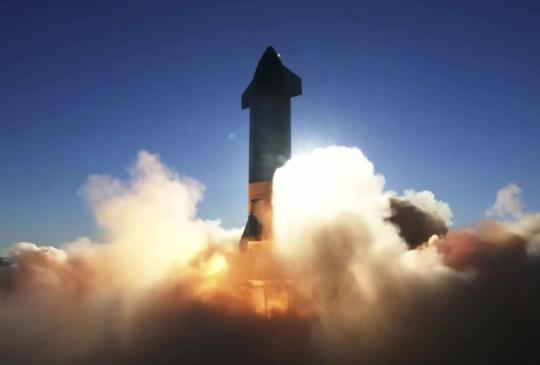
New Post has been published on https://techcrunchapp.com/spacex-launches-starship-on-highest-test-flight-crash-lands-national-news/
SpaceX launches Starship on highest test flight, crash-lands | National News

CAPE CANAVERAL, Fla. (AP) — SpaceX launched its shiny, bullet-shaped, straight-out-of-science fiction Starship several miles into the air from a remote corner of Texas on Wednesday, but the 6 1/2-minute test flight ended in an explosive fireball at touchdown.
It was the highest and most elaborate flight yet for the rocketship that Elon Musk says could carry people to Mars in as little as six years. Despite the catastrophic end, he was thrilled.
“Mars, here we come!!” he tweeted.
This latest prototype — the first one equipped with a nose cone, body flaps and three engines — was shooting for an altitude of up to eight miles (12.5 kilometers). That’s almost 100 times higher than previous hops and skimming the stratosphere.
Starship seemed to hit the mark or at least come close. There was no immediate word from SpaceX on how high it went.
The full-scale, stainless steel model — 160 feet (50 meters) tall and 30 feet (9 meters) in diameter — soared out over the Gulf of Mexico. After about five minutes, it flipped sideways as planned and descended in a free-fall back to the southeastern tip of Texas near the Mexican border. The Raptor engines reignited for braking and the rocket tilted back upright. When it touched down, however, the rocketship became engulfed in flames and ruptured, parts scattering.
The entire flight — as dramatic and flashy as it gets, even by SpaceX standards — lasted six minutes and 42 seconds. SpaceX broadcast the sunset demo live on its website; repeated delays over the past week and a last-second engine abort Tuesday heightened the excitement among space fans.
Musk called it a “successful ascent” and said the body flaps precisely guided the rocket to the landing point. The fuel tank pressure was low, however, when the engines reignited for touchdown, which caused Starship to come down too fast.
“But we got all the data we needed!” he tweeted.
Musk had kept expectations low, cautioning earlier this week there was “probably” 1-in-3 chance of complete success.
Amazon’s Jeff Bezos, who founded the Blue Origin rocket company, offered swift congratulations.
“Anybody who knows how hard this stuff is is impressed by today’s Starship test.”
Two lower, shorter SpaceX test flights earlier this year from Boca Chica, Texas — a quiet coastal village before SpaceX moved in — used more rudimentary versions of Starship. Essentially cylindrical cans and single Raptor engines, these early vehicles reached altitudes of 490 feet (150 meters). An even earlier model, the short and squat Starhopper, made a tiny tethered hop in 2019, followed by two increasingly higher climbs.
Wednesday’s test followed SpaceX’s latest space station supply run for NASA by three days, and the company’s second astronaut flight by less than a month from Florida’s Kennedy Space Center.
Starship is actually the upper stage of Musk’s envisioned moon- and Mars-ships. It will launch atop a mega booster still in development known as the Super Heavy. The entire vehicle will tower 394 feet (120 meters) — 31 feet (9.4 meters) taller than NASA’s Saturn V rocket that hurled men to the moon a half-century ago.
SpaceX intends to use Starship to put massive satellites into orbit around Earth, besides delivering people and cargo to the moon and Mars. Earlier this year, SpaceX was one of three prime contractors chosen by NASA to develop lunar landers capable of getting astronauts on the moon by 2024.
Right before Wednesday’s launch, NASA introduced the 18 U.S. astronauts who will train for the Artemis moon-landing program.
While accepting an award in Berlin last week, Musk said he’s “highly confident” of a human flight to Mars in six years — “if we get lucky, maybe four years.” But Musk is the first to admit his timelines can be overly optimistic.
———
The Associated Press Health and Science Department receives support from the Howard Hughes Medical Institute’s Department of Science Education. The AP is solely responsible for all content.
¶
Copyright 2020 The Associated Press. All rights reserved. This material may not be published, broadcast, rewritten or redistributed without permission.
(function(d, s, id) var js, fjs = d.getElementsByTagName(s)[0]; if (d.getElementById(id)) return; js = d.createElement(s); js.id = id; js.src = "https://connect.facebook.net/en_US/sdk.js#xfbml=1&version=v2.7"; fjs.parentNode.insertBefore(js, fjs); (document, 'script', 'facebook-jssdk'));
2 notes
·
View notes
Photo
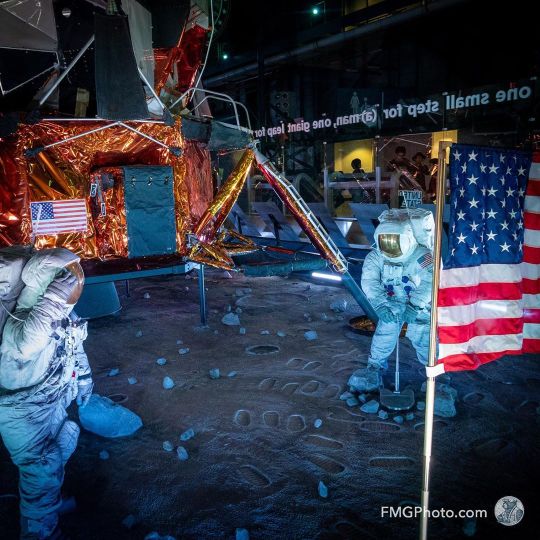
Daily Waypoint | N 28° 31′ 23.88″ W 80° 40′ 54.84″ Saluting Old Glory in front of the LEM— The Apollo Lunar Module, originally designated the Lunar Excursion Module (LEM), was the lander spacecraft that was flown from lunar orbit to the Moon's surface during the U.S. Apollo program. It was the first crewed spacecraft to operate exclusively in the airless vacuum of space and remains the only crewed vehicle to land anywhere beyond Earth. Structurally and aerodynamically incapable of flight through Earth's atmosphere, the two-stage lunar module was ferried to lunar orbit attached to the Apollo command and service module. Its crew of two flew the lunar module from lunar orbit to the Moon's surface. During takeoff, the spent descent stage was used as a launchpad for the ascent stage which then flew back to the command module, after which it was also discarded. The Kennedy Space Center Visitor Complex is the visitor center at NASA's Kennedy Space Center on Merritt Island, Florida. The center is north-northwest of Cape Canaveral on the Atlantic Ocean, midway between Miami and Jacksonville on Florida's Space Coast, due east of Orlando. It features exhibits and displays, historic spacecraft and memorabilia, shows, IMAX theaters, and a range of bus tours of the spaceport. "Space Shuttle Atlantis" exhibit is home to the real Space Shuttle Atlantis orbiter and the Shuttle Launch Experience, a simulated ride into space. The center also provides astronaut training experiences, including a multi-axial chair and Mars Base simulator. The visitor complex also has daily presentations from a veteran NASA astronaut. A bus tour, included with admission, encompasses the separate Apollo/Saturn V Center. https://www.fmgphoto.com/Feature-Special-Galleries/n-W7xDfN/Kennedy-Space-Center/i-dMPpzzf/A https://followingmygps.com/kennedy-space-center/ #KennedySpaceCenter #KSC #CapeCanaveral #Florida #NASA #apollo11 #Apollo #SaturnV #spaceexploration #space #apolloprogram #apollosaturnvcenter #discoveramerica #travelpics #travellife #travelinspiration #travelblog #travelphotography #fmgphoto #followingmygps #travelphotography #traveller #photography #travelamerica #lifestyle #LifeWellLived #tr (at Kennedy Space Center Visitor Complex) https://www.instagram.com/p/CD_nfxOM420/?igshid=1l7wlvvv4y29a
#kennedyspacecenter#ksc#capecanaveral#florida#nasa#apollo11#apollo#saturnv#spaceexploration#space#apolloprogram#apollosaturnvcenter#discoveramerica#travelpics#travellife#travelinspiration#travelblog#travelphotography#fmgphoto#followingmygps#traveller#photography#travelamerica#lifestyle#lifewelllived#tr
1 note
·
View note
Text

Practice makes perfect. Back-up Apollo 11 Commander Jim Lovell prepares for a Lunar Lander Training Vehicle (LLTV) flight, 1969. 3 LLTV’s were built; 2 crashed during training including one flown by Neil Armstrong. Mr. Lovell became the 1st human to fly to the moon twice; once on Apollo 8 in 1968 & once via Apollo 13 in 1970. A13 of course planned to land until an explosion in the O2 tanks crippled the mission. He spent just shy of 30 days in space during his incredible career & flew pivotal flights such as Gemini 7, G12 with Buzz Aldrin, A8 & 13. It’s hard to imagine the 1960s and early 70s space missions without him!
#jim lovell#spaceman#astronaut#apollo 11#astronauts#space exploration#space travel#space race#nasa#space age#space#vintage space#moon landing#1969#space training#aerospace#apollo program#project apollo#1960s#space flight
28 notes
·
View notes
Text
ISRO
Blog by Mobashshar Kibriya
The Indian Space Research Organisation is the space agency of the Government of India and has its headquarters in the city of Bengaluru. Its vision is to "harness space technology for national development while pursuing space science research & planetary exploration".
ISRO built India's first satellite, Aryabhata, which was launched by the Soviet Union on 19 April 1975. It was named after the mathematician Aryabhata. In 1980, Rohini became the first satellite to be placed in orbit by an Indian-made launch vehicle, SLV-3. ISRO subsequently developed two other rockets: the Polar Satellite Launch Vehicle (PSLV) for launching satellites into polar orbits and the Geosynchronous Satellite Launch Vehicle (GSLV) for placing satellites into geostationary orbits. These rockets have launched numerous communications satellites and Earth observation satellites. Satellite navigation systems like GAGAN and IRNSS have been deployed. In January 2014, ISRO used an indigenous cryogenic engine in a GSLV-D5 launch of the GSAT-14.
ISRO sent a lunar orbiter, Chandrayaan-1, on 22 October 2008, which discovered lunar water in the form of ice and the Mars Orbiter Mission on 5 November 2013 which entered Mars orbit on 24 September 2014 making India the first nation to succeed on its maiden attempt to Mars as well as the first space agency in Asia to reach Mars orbit. On 18 June 2016, ISRO launched twenty satellites in a single vehicle and on 15 February 2017 ISRO launched one hundred and four satellites in a single rocket (PSLV-C37), a world record. ISRO launched its heaviest rocket, Geosynchronous Satellite Launch Vehicle-Mark III (GSLV-Mk III) on 5 June 2017 and placed a communications satellite GSAT-19 in orbit. With this launch, ISRO became capable of launching 4-ton heavy satellites into GTO. On 22 July 2019, ISRO launched its second lunar mission Chandrayaan-2 to study the lunar geology and the distribution of lunar water.
After an eventful year in space odyssey in 2019, the Indian Space Research Organisation (Isro) will be working on more than 25 missions in 2020, with the ambitious Gaganyan mission being the most prominent among them.
Aditya-I is India's first dedicated scientific mission to study the Sun. A 400 kg class space telescope will be inserted into a halo orbit 1.5 million km from the Earth to study the three layers of the sun — photosphere, chromosphere and corona, the outer atmosphere of the star in our solar system. The mission is aimed at developing insights on the weather in space and to understand why the outer atmosphere of the Sun is 200 times hotter than the solar disc.
The success of Mangalyaan has prompted the space agency to send a second probe by 2024, which will do deeper studies of the Earth’s neighbour and understand the evolution of the red planet better
ISRO plans to send a second observatory in space. It will be a follow up mission of Astrosat-1 — India's first dedicated multi-wavelength space telescope — aimed at looking at the origin of the universe and discover new planets.
SRO is planning a mission to the Earth’s “twin sister”, Venus. Both the Earth and Venus share similarities in size, mass, density, bulk composition and gravity. The space agency will fly a spacecraft around 400 km over Venus to conduct research and understand its formation, its atmosphere and its interaction with the solar wind.
ISRO and Japan Aerospace Exploration Agency will send a joint mission to the Moon’s south pole. The mission includes landing a rover that will drill the Moon’s surface to conduct scientific experiments. The primary focus will be to explore the existence of water. Japan is likely to provide the rocket and a lunar rover, while India is likely to contribute with a lander for the mission. It would explore the suitability of the region for establishing a sustainable lunar base.
Three Indian astronauts are expected to fly to space in the country’s first human space flight mission in 2021, nearly four decades after Rakesh Sharma made his journey on a Russian rocket in 1984. This time, the Russians are helping India make the space suits and train its astronauts to live in a space capsule for the week-long mission. A Geosynchronous Satellite Launch Vehicle Mk-3, an upgraded version of the rocket that sent the Chandrayaan-2 mission to the Moon, will fly the astronauts and fighter pilots selected from the Indian Air Force to space.
India wants to have a space station up there. The station will help astronauts stay longer in space to conduct experiments. India wants to launch the space station by 2025.
1 note
·
View note
Text
A Machine did Dream of Electric Sheep...
it was in the mid 22nd century that mankind finally made it to mars.
Humanity’s technological prowess finally resolving many of the logistical problems their ancestors could not quite overcome in their time. We had abandoned hope of ever reaching our red sister for over a hundred years, as domestic troubles on the earth stymied technological and scientific research from progressing towards a dream of walking on a distant world.
The nation of China made the first steps towards Mars...by developing the means to survive on the moon. the lunar colonies were a sincere victory towards the pursuit of mars colonization. Without the benefits of the lunar habitats, and the vital life support technologies developed during humankinds occupation of the moon, we would not be able to live and thrive on another world.
The second steps were taken by the nations of India and Pakistan, who set aside their old animosities by working together to develop the infrastructure and engines necessary to transport what we needed to live on the moon from our mother earth in the most efficient means possible.
the third steps were taken by a joint Russia/EU/America coalition. Tentative though it was, the coalition provided the manpower, logistics, and bodies necessary to man the lunar colonies by training astronauts, engineers, and other members of the science community on how to live in a zero g environment, and overcoming the challenges that may arise when things go wrong.
The final journey was completed by private charter, as the whole of our solar system was finally opened up to corporations and manufacturers scrambling to establish toe holds in the resource rich locations within the Kuyper belt, on the moon, and other rich targets all on the backs of technologies developed by the scientific community, and many space agencies run by various governments. Space became our new frontier.
The first mars colony was a private affair. Established by a international think tank of scientists and engineers, backed by corporate sponsorship and resources, and built as a testing ground for colonial habitats. Without that necessary link, humanity would never have been able to establish the colony cities, and begin transporting immigrants to mars. The iron rich Martian soil making it easy to fabricate ships, engines, and structures necessary for survival, and the low Martian gravity a boon to building the superstructures necessary to place stations and manufacturing plants throughout our solar system.
In the year 2269, on the 200th anniversary of humankind first steps on a foreign soil outside our own world, did we find her....
It started off as a lark....a “what if”. What if we found her? What if we brought her back home? What if she still worked after all these long years? It became a sort of competition between the harvesters scouring the surface for iron oxide for the manufacturing plants back in the fabrication domes. Yet, What started out as a friendly competition between colony workers, quickly became a zealous search for lost NASA and other space agency tech, with corporations ponying up hefty sums of money as a reward to the first persons to find the old probes. Almost every Martian kid carried a copy of the old NASA wake-up protocols on their datapads, just in case. Many harvester techs toted a bevy of metal detectors, signal boosters, and a shovel or two should their rigs ping on a solid metal signal....mostly, they just find a plethora of meteor pieces that they just shrug, and toss into the catch bins of their harvesters.
Some of the rewards were already claimed...by lucky techs or citizens who dredged a small bit of old probe up from the Martian dust, and dug on hands and knees to uncover the rare finds. they found the old Viking probes that way, a couple of Russian orbiter probes that fell out of orbit, mangled landing gear from various probes, Beagle 2, Spirit, the sojourner....over the years, since humans first landed on mars, the search for old tech proved too irresistible a challenge for any government to repress, so they encouraged the search and salvage of historical artifacts by Martian natives with the hopes of recovery and return to mother earth..
When they found her, it was not some dusty tech that dredged past, or a maintenance crew on their way between repair stations.....no....it was a family of four on holiday across the Martian plains, crater hopping for meteorite samples for their eldest child’s research paper on “meteorological differences in crystalline alignment between various impact samples within crater impact sites”. It was the youngest child that noticed the shiny glint in the dim sunlight, the corner of a solar panel sticking up at an odd angle.
While the rest of the family were busy gathering samples, the child starts digging at the panel with the toy shovel mom and dad provided to keep the kid happy and occupied while they snap pictures and spectroanalyize samples for their older kid. The youngest giggles while they work, removing layers of dirt from the solar panel inch by inch exposing more and more. A foot scuff in Martian soil uncovers part of a camera lens and the child starts digging around until they uncover a long cylinder attached to a mounting arm in the loose mars soil.
By this time, the rest of the family has joined the youngest after hearing the giggles, and make a concerted family effort to dig out the old rover. Spending several hours removing as much dirt as they can from the solar panels, while talking excitedly amongst themselves, and congratulating the youngest on their discovery. Most of the body, part of the wheels, and the tool arm limply resting beneath the rover now exposed to the sky once again, the family dusts off the rear panel where the words “NASA” and underneath that in smaller lettering “ Opportunity” were printed on the structure panels.
the child squeals “Oppy!” while the parents shed a tear, running down their cheeks and unable to wipe away....their joy and happiness evident over the discovery. The eldest tinkers with some wires underneath the solar panels, and attaches them to a spare battery out of their rented land transport while keying in old codes from the colony database. They wait....
After what feels like an eternity, they could see the twitch of gears, the slight tilt of the camera as it resets, the wheels being tested one by one. the camera head slowly swinging around to look at it’s body...
By this time, the word had gotten out on mars that another lander had been found, which got everyone on mars excited, and flocking towards the now broadcasted coordinate location at best speed, as old monitors in every station lit up with the words “Hello....I am awake, and warm.”
There was quite the reception accumulating at the find site as harvesters, personal transports, mars government officials, everyone not tied down arriving from all directions, and forming a reverent circle around the lander, of vehicles and people.
Caring hands, from all walks of life, pitch in to lift her out of the hole she was currently in, and gently placed the 400kg astronaut back on flat land to the cheers and adulation of the assembled Martian people
The teen types in a series of warmup commands, which takes the lander a few moments to process from her aging memory banks, but her cameras shift, the panels weakly soaking up what little ambient lighting there was. she slowly holds up her tool arm and proceeds to cycle through them testing functionality.
There is not a dry eye in the entire assembly of humans, standing on the Martian plains on that historic day......when they hear the melody of an old Billy Holliday tune being played faintly with Opportunity’s tool arm.....after all that time, it seems she remembered us after all...
We finally found her....and now.....she begins her journey....home.
.
210 notes
·
View notes
Text
Blue Origin launches Bezos on first crewed New Shepard flight
https://sciencespies.com/space/blue-origin-launches-bezos-on-first-crewed-new-shepard-flight/
Blue Origin launches Bezos on first crewed New Shepard flight
VAN HORN, Texas — Blue Origin performed its first crewed New Shepard launch July 20, sending company founder Jeff Bezos and three other people on a suborbital flight.
New Shepard lifted off from Blue Origin’s Launch Site One in West Texas at 9:12 a.m. Eastern on the NS-16 mission. The crew capsule, called RSS First Step, separated from its booster and reached a peak altitude of 107 kilometers before descending under parachutes to a landing 10 minutes and 10 seconds after liftoff. The booster performed a powered landing nearly seven and a half minutes after liftoff.
On board New Shepard was Jeff Bezos, the founder and recently retired chief executive of Amazon.com, who established Blue Origin more than two decades ago. He has invested several billion dollars into the company, creating New Shepard as well as its New Glenn orbital launch vehicle under development, the BE-4 engine and lunar lander concepts.
“Best day ever!” he exclaimed minutes after landing.
New Shepard ascends on its first crewed flight July 20. Credit: SpaceNews/Jeff Foust
Also on board was Mark Bezos, the younger brother of Jeff Bezos, who was invited by his brother to be on the flight. On July 1, Blue Origin announced that Wally Funk, who completed astronaut medical exams six decades ago as one of the “Mercury 13” women, would join the flight. The fourth and final person, Dutch teenager Oliver Daemen, formally joined the crew July 15. Daemen took the place of the winner of a June 12 auction, who bid $28 million for the seat but who later had “scheduling conflicts” that kept that person from flying
At 82, Funk became the oldest person to fly to space, breaking the record set by John Glenn when he flew to space for the second time on the space shuttle in 1998 at the age of 77. Daeman, 18 years old, became the youngest, breaking the record set by Soviet cosmonaut Gherman Titov in 1961 when he flew about a month before turning 26.
The flight was the first time that New Shepard, which started its test flight program in 2015, carried people. The vehicle is designed to fly autonomously, and all previous flights carried only experiments or other cargo.
That series of test flights, capped off by two flights in January and April, convinced Blue Origin it was ready to fly people. “We followed a methodical, step-by-step approach to get to this point in time. We’re ready,” Bob Smith, chief executive of Blue Origin, said at a pre-launch media briefing July 18.
Smith said the company was confident enough in the design to allow four people on the first flight, including Daemen, who is the company’s first commercial customer, rather than fly company personnel. That was based on the two previous flights, which demonstrated that the vehicle is a stable configuration.
“By doing so, we’ve exercised not only the design but also the manufacturing and all of the operations,” he said. “When we had clean flights from both of those, we said, ‘We’re ready to go. We can go fly astronauts and do it safely.’”
While the company is confident to go directly into commercial operations, Smith said the crew of this flight were asked to perform “a few evaluations of capabilities of what we’re seeing in flight.”
“There’s really no difference in how we operate the vehicle and the systems whether they’re employees or commercial customers,” said Steve Lanius, NS-16 flight director, at the briefing. “They’re still human beings.”
The New Shepard capsule descends under parachutes during its July 20 crewed flight. Credit: SpaceNews/Jeff Foust
Jeff Bezos, in a CBS television interview July 19, expressed no reservations about flying on New Shepard. “People keep asking me if I am nervous. I am not really nervous. I am excited. I am curious,” he said. “We’ve been training, this vehicle is ready, this crew is ready, this team is amazing. We just feel really good about it.”
Blue Origin plans to conduct two more crewed New Shepard flights this year, with the first in late September or early October. Smith said the company has seen “high interest” from potential customers, but has not disclosed how many people have signed up or at what prices. Another uncrewed flight, carrying research payloads, is also scheduled for later this year.
#Space
0 notes
Link
Michael Collins, Apollo 11 astronaut, has died at age 90 “We regret to share that our beloved father and grandfather passed away today, after a valiant battle with cancer,” the statement read. “He spent his final days peacefully, with his family by his side. Mike always faced the challenges of life with grace and humility, and faced this, his final challenge, in the same way. We will miss him terribly. Yet we also know how lucky Mike felt to have lived the life he did. We will honor his wish for us to celebrate, not mourn, that life. Please join us in fondly and joyfully remembering his sharp wit, his quiet sense of purpose, and his wise perspective, gained both from looking back at Earth from the vantage of space and gazing across calm waters from the deck of his fishing boat. Our family asks for privacy during this difficult time. Details on services will be forthcoming.” NASA, where Collins spent seven years of his career as an astronaut, also released a statement about Collins’ passing. “Today the nation lost a true pioneer and lifelong advocate for exploration in astronaut Michael Collins,” said acting NASA Administrator Steve Jurczyk in a statement. “As pilot of the Apollo 11 command module — some called him ‘the loneliest man in history’ — while his colleagues walked on the Moon for the first time, he helped our nation achieve a defining milestone. He also distinguished himself in the Gemini Program and as an Air Force pilot. “Michael remained a tireless promoter of space. ‘Exploration is not a choice, really, it’s an imperative,’ he said. Intensely thoughtful about his experience in orbit, he added, ‘What would be worth recording is what kind of civilization we Earthlings created and whether or not we ventured out into other parts of the galaxy.’ “His own signature accomplishments, his writings about his experiences, and his leadership of the National Air and Space Museum helped gain wide exposure for the work of all the men and women who have helped our nation push itself to greatness in aviation and space. There is no doubt he inspired a new generation of scientists, engineers, test pilots, and astronauts. “NASA mourns the loss of this accomplished pilot and astronaut, a friend of all who seek to push the envelope of human potential. Whether his work was behind the scenes or on full view, his legacy will always be as one of the leaders who took America’s first steps into the cosmos. And his spirit will go with us as we venture toward farther horizons.” Edwin “Buzz” Aldrin, former NASA astronaut and lunar module pilot of the Apollo 11 mission, shared his sadness at Collins’ passing. “Dear Mike, Wherever you have been or will be, you will always have the Fire to Carry us deftly to new heights and to the future. We will miss you. May you Rest In Peace. #Apollo11,” Aldrin wrote on Facebook. Collins was born in Italy, became an Air Force pilot, then an astronaut in the Gemini program. He was the third American to perform a spacewalk, according to NASA. Including the Apollo 11 mission, Collins logged 266 hours in space, NASA said. In 2019, Collins sat down with CNN Chief Medical Correspondent Dr. Sanjay Gupta to reflect on the 50th anniversary of the historic Apollo 11 mission. Collins reminisced about looking up a the sky as a child, seeing “the most marvelous things up there” and wanting to know more about them, he told Gupta. That’s when he knew that he wanted to fly. Becoming an astronaut Collins came from a military family. His father and brother were US Army generals, and his uncle was the Army chief of staff. He decided to “sneak off” to the US Air Force instead. In 1961, Collins was a student at the US Air Force Test Pilot School at Edwards Air Force Base in California. That year, President John F. Kennedy said that the United States would put a man on the moon by the end of the decade and return him safely to Earth, Collins remembered vividly. Collins and about 80% of his peers were “gung-ho,” he recalled. NASA and the idea of the Mercury and Gemini programs, which set up for the Apollo program, were attractive, and the space program seemed like a promotion. The other 20% would rather fly and test new airplanes for the Air Force rather than getting “locked up in a capsule and shot off like a round of ammunition,” Collins said. Collins, a fighter pilot for four years, graduated flight school at age 22. He “flunked out” the first time he applied to the space program. He says there are 15 or 20 reasons why he might have flunked, but he likes to tell the story of the famed Rorschach inkblots mishap during his psychiatric exam. “I leafed through a whole series of them, and then the last one was a blank sheet of paper, pure white, 8 by 10,” he said. ” ‘Here, so what do you see?’ they asked. I say, ‘well, of course that’s eleven polar bears fornicating in a snowbank.’ And I could see the examiner’s eyes kind of tighten. He didn’t think that was funny. He didn’t like people making light of his card set. Anyway, for whatever reason, I flunked. The next year, (in the inkblot) I saw my mother and my father, and my father was slightly larger and more authoritarian but not too much more than my mother, and I passed.” Collins was selected as part of the third class of astronauts in 1963. His first mission was Gemini 10. His second was Apollo 11. The six years between 1963 and 1969 flew by. Collins and his fellow astronauts worked hard, rising early and neglecting breaks on the weekends. They rarely saw their families and flew from coast to coast, visiting facilities where parts of the spacecraft were being manufactured. They attended classes to learn everything about the spacecraft they would be flying and spent countless hours in simulators that replicated their missions to conquer every possible error. Physical fitness was not one of the NASA requirements, Collins said. The astronauts had an initial thorough exam before they were accepted into the program, testing their senses and capabilities. But after that, physical fitness was up to the individual to maintain. “We had an annual physical exam that we had to pass, and it was an extremely rigorous exam. They would assign two flight surgeons to one of us, and one would look in this ear, and one would look in that ear. If they didn’t see each other, you passed,” he joked. “That was the physical exam that NASA offered us, and they required us to really do whatever we felt like we should be doing in terms of our own conditioning.” At the time, one of the requirements to become an astronaut was graduation from an accredited test pilot school. Test pilots were used to mental stress and physical danger, so Collins believes that NASA was more focused on other aspects. The agency’s priority was making sure that the astronauts could operate a complex machine that would be going a quarter of a million miles from Earth for the first time. Apollo 11 Collins learned that he would join Buzz Aldrin and Neil Armstrong on Apollo 11 during a call from Deke Slayton, whose résumé included World War II pilot, test pilot, one of the original Mercury Seven astronauts and NASA’s first chief of the Astronaut Office and director of Flight Crew Operations. He put the crews together and was “sort of one of those unsung behind-the-scenes heroes,” Collins said. “He was a wonderful, wonderful boss.” Slayton called Collins and asked, “Hey, you still want to do this thing?” “Oh, absolutely!” Collins replied. “You better believe!” Kennedy’s wish loomed large in Collins’ mind. Then 39, he felt the astronauts carried the weight of the world. He didn’t talk about the dangers of spaceflight with his wife, Pat. “We talked about superficialities and maybe alluded to those serious difficulties that a space flight entails,” Collins recalled. “We’d nibble all around the edges of the danger involved.” Launch day on July 16, 1969, arrived quickly. The three astronauts got out of their vehicle at the base of a tower that went 365 feet into the air. An elevator took them up to their command module, Columbia. Everything had to be “all neat and apple pie” before they could board. Collins looked to his left and saw a clear ocean. On his right was “the most gigantic pile of complex machinery you’ve ever seen.” “And I can remember thinking ‘ooh, I think I’d rather look at the simple one rather than that complicated one. Maybe that’s too complicated for me over there.’ ” The men knew that the chances of it failing somewhere along the line were relatively high, but they were optimistic about surviving, Collins said. After that, the mission unfolded in a series of imperative events. “I liken it to a daisy chain, long and very fragile daisy chain,” Collins said. “It emanates from Cape Canaveral, and then it goes out into space and around the moon and circles it back in. And it’s got all these links in it, and if one link fails, well, all the rest downstream are useless. So for eight days, to and from, there was always one thing coming up, the next big event which could ruin you, be the end of you. That was how it worked.” While Aldrin and Armstrong separated from Columbia in the lunar lander, the Eagle, to land on the moon, Collins kept circling the moon. Once Armstrong and Aldrin were finished, he would rendezvous and dock with the Eagle after it left the lunar surface. That maneuver was the one they had prepared for most during training on Earth. Collins had a 8-by-10 notebook with 18 scenarios around his neck. It went perfectly. Collins was often called “the loneliest man” once he returned to Earth, but he didn’t feel that way — even when he lost contact with Mission Control during his flybys on the far side of the moon. While Armstrong and Aldrin were busy landing, setting up experiments and collecting samples from the lunar surface, Collins had to keep all of the subsystems running on Columbia by himself. “It was a happy home. I liked Columbia,” he said. “It reminded me, in a way, of almost like a church or a cathedral. It had the apse, the three couches, and then you went down into where the altar was. That was the guidance and navigation system. And it was laid out almost like a cathedral. And I had hot coffee. I had music I could play if I wanted to. I had people to talk to on the radio, sometimes too many people talking too much on the radio. So I enjoyed that interlude. Being by myself in a machine up in the air somewhere was not unknown to me, and so everything was working well within Columbia, and I enjoyed it.” When the three men were reunited after the docking, Collins wanted to celebrate with Aldrin and Armstrong. But they had mission items to tend to. The daisy chain wouldn’t be complete until they landed safely on Earth. “I remember I was going to grab Buzz by the shoulders and kiss him on the forehead, and then I decided, ‘No, that’s just not right.’ So I don’t know. I shook his hand or patted him or something. And Neil, I didn’t even bother touching Neil when he came through. That was it. We didn’t say ‘oh, you have landed on another planet’ or anything like that.” Although Collins did look for the little bit of cognac he thought they had stowed away, he never found it. After the successful Apollo 11 flight, Collins saw another side of Armstrong as the three astronauts embarked on a trip around the world to talk about their experiences. Armstrong was their spokesman. “He was just amazing,” Collins recalled. “He’d delve into the background of this thing and that, and wherever we went, he’d pick out details that appealed to the local population, and you could see by the time he got through his little introductory speech, they almost felt like they were crawling on board with us. “It was just an amazing feat, and I think he’s often overlooked in a way. First Man — he’s not overlooked. But what people maybe don’t know about First Man was that First Man was one marvelous proponent of the virtues of the United States and spread those all over the globe.” The three men didn’t remain in close touch afterward, mainly because Collins lived in Washington, Armstrong lived in Ohio and Aldrin moved around. It wasn’t easy to get together. But they had shared in something wonderful and fulfilled Kennedy’s mandate. Life after Apollo Apollo 11 was the proudest moment of Collins’ life. He may not have had the best seat on Apollo 11, but he was happy with the seat he had, he said. He felt privileged to be there. His biggest regret was for those who couldn’t be there — pilots who died in training accidents along the way, the Apollo 1 astronauts and his friend Charlie Bassett, who died in an airplane crash. “I thought ‘boy, he’d be right up there at the tippy-top of the list of who goes first on the moon.’ So I regret that aspect of it.” After his return, Collins retired from NASA, wanting to spend more time with his family. “Pat and I took on a totally different kind of life,” he said. “I figured I’d done the space thing and at the highest level,” he said. “I made a speech at a joint session of Congress and the Secretary of State, Bill Rogers, liked it, and he got President Nixon involved. And so the next thing I know, I was offered a job as assistant secretary of state. A little less than two years when up popped one that I was better qualified for, which was the director of the Air and Space Museum of the Smithsonian, and that was just getting started. I started with a vacant lot and a hole in the ground and then a building and so forth.” Collins began running with astronaut Ed White during the Gemini program and ran 50 miles when he turned 50, completing triathlons along the way. When Gupta spoke with him in 2019, Collins was still speaking about the virtues of exercise and the Mediterranean diet. He cited “2001: A Space Odyssey” as his favorite movie. If there’s one question he grew tired of hearing after all of these years, it was “what was it like up there?” It’s part of why he wrote his 1974 book, “Carrying the Fire,” which was re-released for the Apollo anniversary. Throughout the Apollo mission, Kennedy’s wish was in the back of Collins’ mind. He reflected on that aspect of the mission 50 years later. “Apollo 11 was the culmination,” he said. “We were finally able to do what Kennedy had asked us to do, and so I think Neil and Buzz and I, all three, we felt that this was a culmination of a long, successful series. And we tried our best to fulfill it.” Seeing the moon up close was spectacular, but he recalls that the view of Earth kept snaring the astronauts’ attention. “I said ‘Hey, Houston, I’ve got the world in my window,’ ” Collins said. “And the world is about the size of your thumbnail if you hold it out arm’s length in front of you. The whole focus of your attention goes into this little thing out there. It’s in a black void, which makes its colors even more impressive. Primarily, you get the blue of the oceans, the white of the clouds, you get a little streak of tan that we call continents, but they’re not that noticeable. It just looks glorious.” But Collins noticed something unique about his perspective of our home planet. “Strangely enough, it looks fragile somehow,” he said. “You want to take care of it. You want to nurture it. You want to be good to it. All the beauty, it was wonderful, it was tiny, it’s our home, everything I knew, but fragile, strange.” CNN’s Samantha Bresnahan and Amanda Sealy contributed to this report. Source link Orbem News #Age #Apollo #astronaut #Collins #died #MICHAEL
0 notes